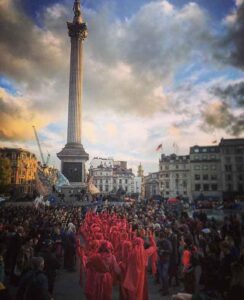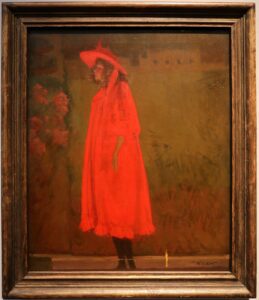
On August 11, 2019, on Porthmeor beach, St Ives, Cornwall, crowds of holidaymakers are doing what holidaymakers have always done on blue and sunny Sundays at the peak of the season. Unannounced and seemingly out of nowhere, lines of bizarre silent figures appear, each swathed from head to foot in flowing red draperies, their faces deathly pale, movements slow and stylised as if directed by an unseen voice. A procession of banners and flags in their wake makes clear that this is an Extinction Rebellion protest about the impact of climate crisis on the sea. The tourists move aside to let them pass, smiling or looking baffled; children point, people raise their phones. The robed figures pause, lifting gloved arms in a baroque crimson tableau on the sand, Tate St Ives art gallery rearing up like a cliff behind.
But one man stays put, kneeling on the beach at their feet. Isolated now, naked to the waist in his holiday shorts, he continues to do exactly what he was doing before, which was digging a big hole in the sand. A child (perhaps his own), has lost interest in this hole and stares uneasily around. The man cannot possibly be unaware of the red spectres, or that the space around him has emptied, but he certainly acts as if he is – doggedly digging – and when occasionally he does look up, his gaze is always directed determinedly away from the action. Finally, the red figures walk away together into the sea up to their waists, garments pooling like blood on the
waves.
The poor man may simply have been embarrassed, or resistant to crowd psychology, but it would be hard to come up with a more precise metaphor for the climate emergency, simultaneously illustrating fossil fuel extraction and resolute denial of its effects on the planet. The filmmaker (Senara Wilson Hodges) confirms that the incident occurred spontaneously and was not staged.
Along with the distinctive black hourglass symbol, the Red Rebel Brigades have become one of Extinction Rebellion’s most vivid motifs, flaring up like wildfires across the world, lending wordless support to actions and protests. Their power seems to derive from two sources. The first is incongruity, as seen at St Ives: an unexplained, unnerving presence in the mundane backdrops of normal life – which instantly questions that normality, so that the artless reactions of passers-by become suddenly eloquent, the idea of the ‘innocent bystander’ contentious. This effect was repeated in Truro, Cornwall, during a protest about fast fashion. The Red Rebels stood as if in mourning over a shopping street strewn with the prone bodies of demonstrators acting dead. Right in the middle of all this, a group of four people remained seated on a bench, oblivious, eating pasties. Shoppers paused, faces registering curiosity or anxiety, while others just walked on by. The film of this event is both beautiful and melancholy, capturing the slow drift of scarlet veils reflected in the shopfronts of Primark and New Look.


The second, more subtle, power of the Red Rebels lies in a teasingly elusive visual familiarity inspired by the costumes. You feel you have seen them somewhere before, perhaps in a Renaissance painting, a film, a history book, a carnival, an allegorical fresco: the headdress and grave expressions recall Bronzino’s portrait of Lorenzo the Maghnificent (1560), Jan Van Eyck’s Man in a Red Turban (1433), Robert Campin’s 15th century Portrait of a Man, or perhaps Walter Sickert’s wraithlike Minnie Cunningham at the Old Bedford (1892). The use of red is deliberate, signifying vitality and mortality, the “common blood shared with all species”, while the style of the costumes was adapted from those created by an older group called Invisible Theatre. Red compels the eye, setting up an automatic contrast with grey urban settings and green rural ones alike, and a contrast also with the gentle, hypnotic gestures used by the actors. It’s a colour that taps into archetypes and folktales (Red Riding Hood, blood on snow) and literary memories, the most apt of these being Edgar Allan Poe’s story Masque of the Red Death (1842). In the latter, a coterie of the rich and powerful, fearful of the red plague (described as a sort of haemorrhagic fever) quarantine themselves in a castle (gated community) while the common people die outside. When an uninvited guest appears at a grand party tactlessly costumed as the Red Death he provokes fear and rage, though when he is unmasked there is nobody under the costume – the face of death is everyone’s and everywhere, and everybody is fatally infected.
Historical echoes haunt photographs taken at various XR actions, an effect amplified when the Red Rebels are in the shot. Compare a picture taken in Trafalgar Square this October by Catherine Ames, for example, with a colour print from 1793 in the midst of the French Revolution. The latter shows a fete in honour of the Supreme Being – semicircles of red-clad figures in the crowd, while Ames’ 2019 photo seems abstracted out of time, a swathe of yellow at the edge of the windblown sky echoing an almost identical sky in Delacroix’s Liberty Leading the People (1830). The sense of cultural recognition triggered by the Red Rebels may also owe something to the unconnected but fortuitous appearances of red handmaids as agents of protest, following the TV adaptation of Margaret Atwood’s The Handmaid’s Tale.
Extinction Rebellion has only existed for a year, but a striking design aesthetic emerged fast. Within months the hourglass symbol was becoming as recognisable as the CND peace sign or the hammer and sickle; posters appeared with varying messages but a shared graphic identity – a solid black typeface reminiscent of Futura Bold, on green, mauve, blue or yellow. No doubt this cohesive look was seen to be necessary, given the scale and complexity of the climate and biodiversity crisis and the multiple targets addressed – past protests and rebellions, even revolutionary ones, have had narrower, human-centric aims. Most obviously new was the hard-edged, unsentimental quality in the design – nothing dreamy or New Age, no watercolour flowers, nothing wholesome or reassuring: the bee woodcuts are stark, anatomically correct, likewise the butterfly and the sheep’s skull. These graphic principles seem to be providing a frame within which local groups are creating their own posters, banners and paintings. While most of these creations will be instrumental in intent and execution, others, more original, raise questions about borderlines between propaganda, mythmaking, art as rebellion, and art of lasting importance. Crises and revolutions have produced all of these in the past, and the French revolution is a good example – Jacques Louis David was a propagandist for the revolution, then a mythmaker for Napoleon; he was also indisputably a formidable artist.
Artists often say that their inspiration is idiosyncratic and subconscious, and this, combined with the enormity of the questions posed by the climate emergency, make it difficult to generalise about how they are responding. A recent article in the New Statesman (5 December) accuses both the curators and the exhibitors in the Royal Academy’s current Eco-Visionaries show of melancholic self-indulgence and political passivity: “a lachrymose hand-wringing that fails to meet the emergency of the climate crisis”. But artists are not politicians or corporations, and may not be temperamentally inclined to activism; if the value of individual response is discounted, then so is the value of all art, in all its forms.

It might be instructive to contrast the work of just two artists. In September 2019, just three weeks before the start of the October Rebellion in London, Damien Hirst exhibited decorative colour wheels composed of dead butterflies – thousands of them, wings detached from their bodies. You might say, as Jonathan Jones wrote in The Guardian, that these works are “mystical, ecstatic paintings” or alternatively you might call it a grotesque display of ecological vandalism. Judging by the photographs, a curious effect of his rigid patterning of multiple species is to nullify and sterilise their iridescent beauty, creating migrainous mandalas in homage to the idea that the natural world is a limitless resource to be raided by humanity.
Meanwhile, in Wales, another artist, Ceri Leeder, has been creating paintings which combine a powerful emotional connection to nature with grief at its destruction. But Leeder’s work contains that mysterious extra element, a hidden narrative, or perhaps an objectivity – the splinter of ice that separates art from decoration or illustration of a message. In Sea Vision, the figure of the artist stands at an easel to the left of the picture, painting the calm seascape outside, while a great wave surges in through the window, surf washing over the floorboards around the painter’s feet. In its twin, Sea Dream, we are in the same room, but the sea is now everywhere, a huge fish swimming beside a bed containing a small sleeping figure. These pictures (executed in egg tempera) are open to multiple interpretations, and convey terror, beauty, and an odd sense of inevitability or submission. Her ink drawing titled We Can Fight This recalls Samuel Palmer’s moonlit sheep, until a closer inspection shows it to be a row of detached heads lying amid ruins – a serene image of destruction that is countered by her studies of a leafless tree titled Mars Rising, Still Hope which point to sources of optimism in nesting birds, a single wild flower. Ceri Leeder says that Extinction Rebellion has “tapped into a huge resource, a democratisation of art.” Hopefully there will be people who survive to judge this defiant explosion of innovation and creativity in the future.
Josephine Gardiner
Volume 34 no 3 January – February 2020 pp 7-9
